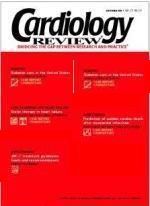Publication
Article
Cardiology Review® Online
CRP-CHD link may be weaker than previously thought
The association between C-reactive protein (CRP) and the risk of coronary heart disease (CHD) may be weaker than previously believed, according to researchers from the United Kingdom. Their study demonstrated about a 1.5-fold increased risk of CHD over the long term in persons with high baseline CRP values compared with low CRP values.
As reported in The New England Journal of Medicine (2004;350[14]:
1387-1397), John Danesh, MB, ChB, DPhil, at the University of Cambridge, and colleagues measured baseline CRP concentrations in 2,459 patients who had a nonfatal myocardial infarction or died of CHD during follow-up and 3,969 controls without a CHD event. Participants were followed up for about 20 years.
The long-term consistency of CRP measurements, as determined by paired samples taken 12 years apart from 379 of the participants, was similar to the long-term consistency of values for systolic and dia-stolic blood pressure, total cholesterol, and other serum markers, such as erythrocyte sedimentation rate (ESR) and von Willebrand factor. Therefore, inflammatory markers are sufficiently stable for use as long-term predictors of CHD, according to Dr. Danesh.
After adjusting for smoking status and other established CHD risk factors, persons with CRP values in the top third (> 2.0 mg/L) had a 45% greater risk of a CHD event compared with persons with CRP values in the bottom third (< 0.78 mg/L).
By comparison, persons with ESR values in the top third had a 30% greater risk of an event compared with persons with ESR values in the bottom third, and those with values for von Willebrand factor in the top third had a nonsignificant 11% increased risk of an event compared with persons with values for von Willebrand factor in the bottom third. Among the established risk factors, elevated total cholesterol more than doubled CHD risk and cigarette smoking increased risk by 87%.
The finding with respect to CRP and CHD risk was consistent with that from a meta-analysis updated to include a total of 7,068 patients. In previous studies, published before 2000, elevated CRP concentration was associated with about a doubling in the risk for CHD events, noted the authors.
In comparison with major established risk factors, “the C-reactive protein concentration was a relatively modest predictor of the risk of coronary heart disease and added only marginally to the predictive value of established risk factors for coronary heart disease,” wrote the authors. They added that recent
recommendations from the Centers for Disease Control and Preven-
tion (CDC) and the American Heart Association (AHA) on the use of CRP in the prediction of CHD may need to be reviewed. The CDC and AHA suggested in a position paper published in 2003 that CRP may be “reasonable” to measure in patients who are considered to be at intermediate risk of CHD based on an assessment of established CHD risk factors. According to Danesh and colleagues, the report acknowledged, however, that the epidemiologic data to support this view were not entirely consistent and recommended that larger prospective studies be conducted to improve the reliability of the evidence.
